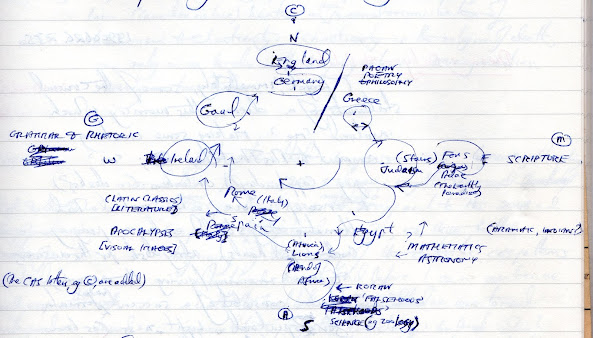[Redbook7:161][19900630:1400]{Artistic
Cycles (1)}[30th June 1990]
19900630.(1400c)
Note:
A.S. Byatt ‘After the myth, the real’, reviewing 4 books on Van
Gogh, T[imes] L[iterary] S[upplement], 19900629-0705, 683ff,
particularly discussion of Zola’s novel, ‘La Faute de L’Abbé
Mouret’, and its (and Van Gogh’s) living ‘symbolism’ or
patterns of Christian death and pagan resurrection. & cf
Independent Weekend today,* p27, reported comment of Innu (Canadian
native) hunter on their personal reconciliation of Shamanism and
Christianity: ‘Christianity is the religion of death; our religion
is to do with keeping alive. Everyone dies. Everyone tries to
live.’**
The
notion that Expressionism,*** flourishing as it did from c1900 to
1935, might represent the 64-year C point at 1920 magnified on the
approach to the 2048 a.d.**** C point (but what about 1984?), and
thus be the beginning of that map of the artistic C[ircles]
A[nalysis] & S[ynthesis] patterns which I have to find before I
can continue with the booklet# – increased an excitement generated
by Byatt’s article:#*
*(Ind[ependent]
[19]900630, 27)
**cf
[The
Guardian, 19900920 Malcolm Bradbury, ‘The World after the Wake’
(annotated with Circles Analysis & Synthesis 64-year &
512-year cycle degrees)],
313A <901011>
***cf
E[nyclopaedia] B[ritannica] 4:635
****And
cf: “Within the history of Modernism the notion of a ‘recall to
order’ is usually associated with the widespread neo-classical
revival in European painting immediately following the First World
War.” (T[imes] L[iterary] S[upplement] 19900622-28, 669, R. Snell,
‘A dialogue with tradition’.)
Now
see [[Redbook7:164][19900702:2310]{Artistic Cycles (2)}[2nd
July 1990]] (p164)
<19200702>
#[S&C]
#*[continues
in next ts & blog journal entry]
[continued]
[PostedBlogger21062021]


